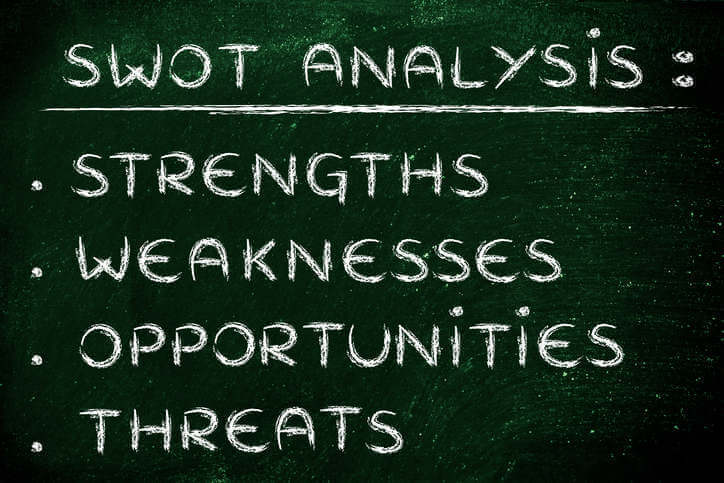When you conduct a SWOT analysis of your business’ marketing efforts, you’re closely examining its strengths, weaknesses, opportunities and threats (hence the acronym “SWOT”). In other words, you’re taking a hard, honest look at its performance, and its potential to better inform your marketing strategy.
To be clear, this blog post focuses on analyzing your business’ marketing efforts, not your entire business model.
What is a SWOT Analysis used for?
Performing a SWOT analysis leads to a deeper understanding of your business’ situation in order to aid in strategizing, problem solving and decision making.
A well-performed analysis will lead to the following insightful data:
- Identification of problems within your marketing efforts.
- Exploration of solutions to those problems.
- Understanding of opportunities for growth and development.
- Adjustment of marketing plans in areas where goals are not being met.
Examining the SWOT of your Business’ Marketing Efforts
Strengths
It’s usually easy to identify your business’ strengths.
Start by reviewing your branding. Do you have a readable, recognizable logo? A strong brand name with a good reputation? Both of these are key to maintaining a coherent brand.
Next, review your actual marketing efforts. Which mediums are doing well? Social media? Email? Make note of how you use each medium to your advantage.
For example, Twitter may have proven effective in resolving customer service issues, while remarketing ads may have brought in an abundance of leads. These are worthwhile strengths to list.
By assessing your strengths, you’ll know which areas of your marketing strategy don’t need to be restructured. You’ll be able to focus your energy elsewhere, like on your weaknesses.
Weaknesses
As for weaknesses, you’ll want to consider areas in which your marketing campaigns are failing to reach their goals.
Let’s pretend you’re not receiving as much Facebook interaction as you’d like. Ask yourself why. Are you using outdated practices? Are you failing to reach the right audience?
Evaluating your weaknesses honestly, without making excuses, will make room for improvement in the future.

Opportunities
When considering growth opportunities your business can leverage, you’ll have to do a bit of outside research. Ask questions such as the following:
- Is there any new technology on the horizon that will allow your business to improve its marketing plan?
- Have there been any new social developments, such as demographic changes, that can inform your marketing campaigns?
- Are there any holidays coming up that can be used as marketing inspiration?
Most successful marketing relies on context. The opportunities you identify grant you that context, so be thorough.
Threats
As you explore opportunities for growth, potential threats may also become apparent. Social and technological developments could affect the demand of your product or service.
For example, accounting firms have been threatened by the rise of DIY tax software like TurboTax. In order to bring in new clients, they must communicate the value of their service that appeals to people considering TurboTax as an alternative.
Study your competitors as well. If they’re growing, they could cut into your customer base. You’ll have to find a way to retain your customers.
Turning SWOT Insights into Strategy
After you’ve performed a thorough SWOT analysis, it’s time to use the insights it provided to generate a new marketing strategy. Allow your strengths and weaknesses to inform how you’ll pursue opportunities. At the same time, consider how potential threats may exploit your business’ weaknesses, and how your strengths can minimize the impact.
Remember that honesty is the best policy when performing a SWOT analysis. An objective examination will help you decide which steps to take next to improve your marketing efforts.



